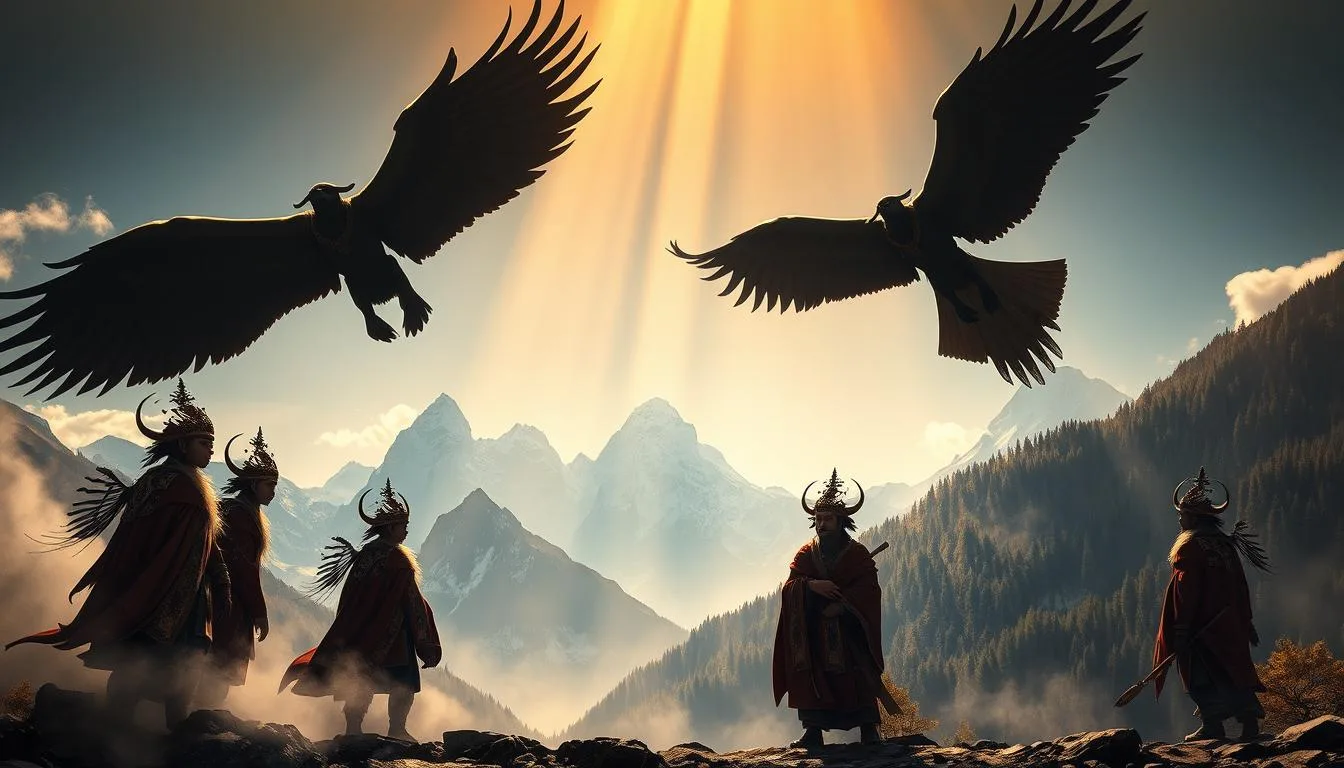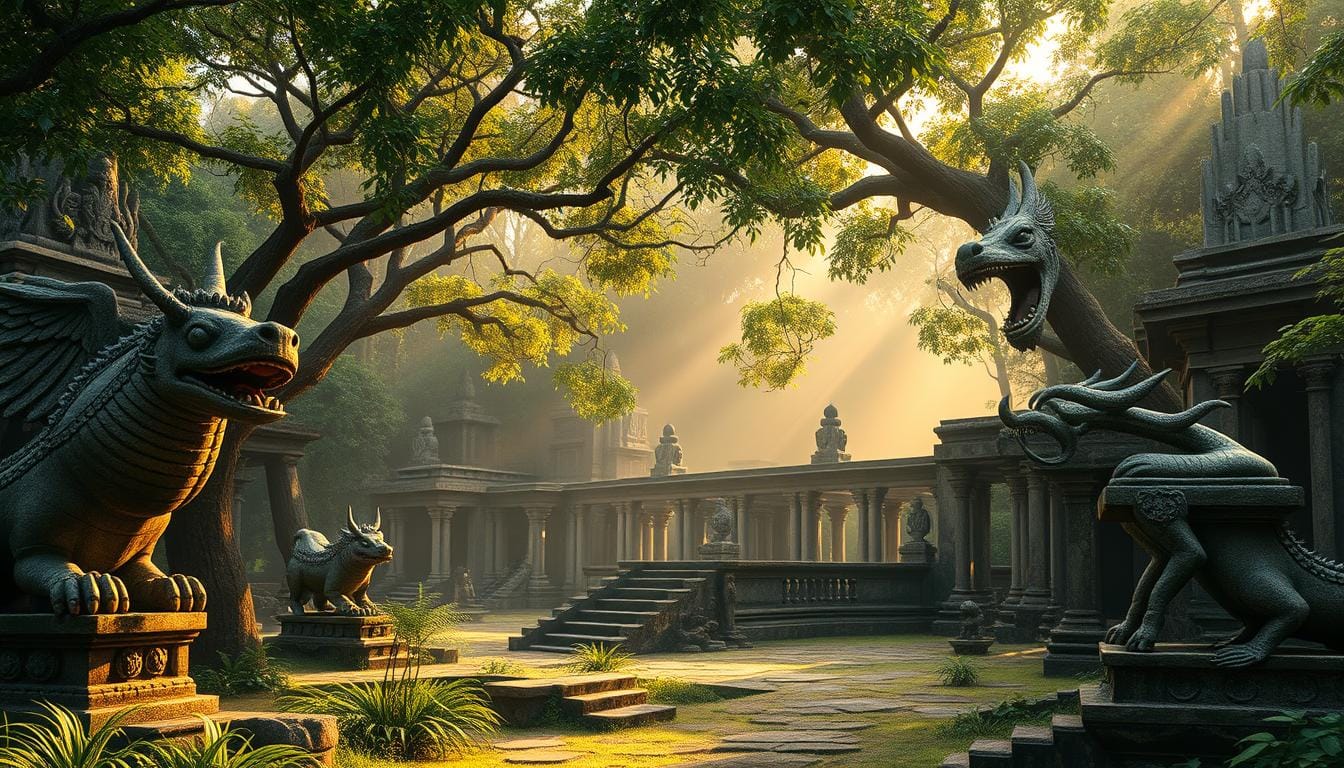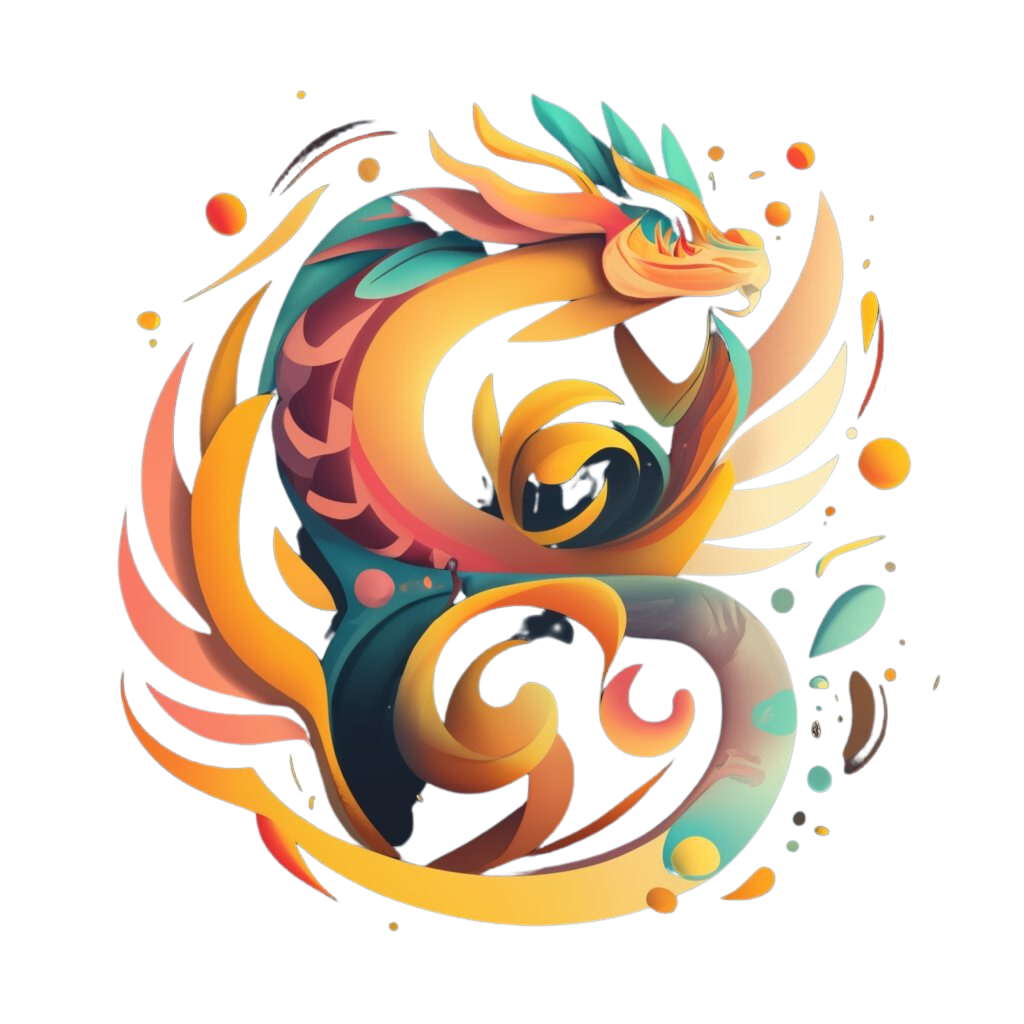South Asia's ancient legends bring mythical creatures to life. These stories are found in India, Pakistan, Bangladesh, Nepal, Bhutan, Sri Lanka, and Afghanistan. They mix magic with history, shaping our understanding of the world.
These creatures symbolize nature's power and human values. In Sri Lanka, flying serpents are part of the myths. In Afghanistan, mountain guardians watch over the land. These tales explain rivers, mountains, and daily challenges.
Let's explore how these stories connect cultures today. See why ancient legends are still alive in art, festivals, and traditions. This journey shows the magic that unites South Asia's vibrant heritage.
Understanding the World of Myth and Magic
South Asian folklore is filled with stories passed down for generations. These tales come from the Himalayas to the subcontinent's plains. They explain the unknown, blending human curiosity with imagination.
Origins of Ancient Legends
Many myths started as stories in villages and royal courts. In places like northern India and Pakistan, tales of shape-shifting spirits or gods were common. These stories reflected the cycles of nature or taught moral lessons.
Over time, these stories grew, influenced by religions and trade. Today, they are still loved and told.
Cultural Significance in South Asia
South Asian folklore is a big part of everyday life. Festivals like Holi and local rituals often include mythical characters. This reminds communities of their shared history.
These stories teach values, explain traditions, and connect people to their ancestors. Even in busy cities, elders share tales of forgotten gods. This keeps these legends alive.
Indian Mythical Beings and Their Symbolism
India's myths are full of symbols that touch every part of life. Creatures like Garuda and Hanuman teach us important lessons. Garuda, with his eagle-like form, stands for freedom and divine strength. His stories teach us about the balance between being strong and wise.
Hanuman, the monkey god, shows us devotion and bravery. His epic feats in the Ramayana inspire us to be loyal. Nagas, the serpent beings, are linked to water and fertility, reminding us of nature's might. People still honor them during monsoon rituals, mixing myth with everyday life.
Indian myths often reflect human values and fears. The Pishacha, a forest spirit, warns us against greed. The half-human, half-animal Vyali guards temples, teaching us to live in harmony with nature. These stories teach us about morality, resilience, and caring for the environment.
Today, these beings are still celebrated in festivals, art, and family stories. Their meanings evolve but remain true to their roots. Each story reflects India's deep cultural heritage.
Exploring Pakistan's Enigmatic Legends
Pakistan's landscapes are filled with tales of legendary beings. These stories mix mystery and morality. They are shared in markets and villages, carrying lessons and wonders.
From the Indus Valley to the Karakoram, these tales show resilience and imagination. They are found across diverse communities.
Traditional Folk Tales
Stories like the Pishacha, ghosts that eat flesh, and the Bhand, shape-shifting tricksters, are common. They are part of oral traditions. These tales often explain natural phenomena or reinforce social norms.
They have been passed down through generations.
Local Interpretations and Beliefs
In Balochistan, the Djinn are both feared and respected. They are believed to live in deserts and valleys. Sindhi communities tell stories of the Daeva, water spirits linked to irrigation and harvests.
Such beliefs shape rituals, festivals, and daily decisions. They show that myths are still living traditions.
These tales have evolved, appearing in films and literature. Yet, they still hold their ancient core. They remind us that even in a changing world, these stories endure as cultural anchors.
Bangladesh: Tales of the Ancient and Mysterious
In Bangladesh, stories from old times mix magic with everyday life. Villages share tales of spirits and supernatural beings. These stories have shaped local beliefs for centuries.
Tales like the Barnanasi, a clever witch who casts spells under the moon, or the Boksi, a bat-like vampire that haunts rivers at dusk, show a world where myth and reality blend.

These stories often talk about living in harmony with nature. The Bhai Phong, a spirit of bamboo groves, teaches people to respect nature. Laily, a star-crossed lover turned celestial spirit, teaches about resilience through stories passed down through generations.
Today, these stories live on in festivals and folk art. Puppet shows tell the story of Manasa, a goddess, and her battle with serpents. Artisans carve mythical creatures into wood and textiles. These traditions keep ancient wisdom alive, connecting Bangladeshis to their heritage.
Like its South Asian neighbors, Bangladesh's myths are more than just stories. They explain natural wonders and moral lessons. Exploring these tales, you find common themes with Indian or Nepali legends, but they are uniquely connected to Bangladesh's landscapes and history.
When exploring South Asian folklore, the stories of Bengali mythical creatures: tales of magic and myth reveal unique spirits, deities, and legends that continue to shape Bengal’s cultural identity.
Nepali Folklore: Creatures of the Himalayas
Nepal's culture is deeply connected to the Himalayas. The mountains inspire stories of mystical beings. These tales mix spirituality with nature, shaping community views.
From ancient shrines to village festivals, these myths live on in daily life.
Mountain Myths and Spirituality
Local legends tell of Yeti-like figures and mountain deities guarding glaciers. Stories of wind spirits, like the “Lakhe,” warn against disturbing sacred places. Monasteries and pilgrims honor these beliefs, linking them to Buddhist and Hindu traditions.
The cultural heritage of Nepal's highlands shows a balance between humans and the divine.
Regional Variations of Legends
Eastern valleys whisper of water spirits in rivers. Western villages tell tales of forest guardians. Each region adapts myths to its environment, creating a mosaic of stories.
These variations show how cultural heritage evolves through geography. Elders pass these tales to youth during harvests and ceremonies, keeping traditions alive.
Bhutan's Mystical Spirits and Guardians
In Bhutan's misty valleys, ancient spirits and guardian deities are part of everyday life. These mystical beings are not just old stories. They are close friends to many, shaping traditions and rituals.

Protective Deities in Myth
Myths speak of the migoi, like yetis, roaming remote forests. They also mention the lha, mountain gods watching over villages. Bon and Buddhist traditions mix here, with fierce protectors like Pelden Lhamo in monasteries.
Each spirit has a special role. Some give blessings, others keep away bad things. Their stories are passed down through generations by word and sacred texts.
Integration with Daily Life
Farmers leave offerings at shrines before planting. Families hang prayer flags to attract good forces. Even in modern cities, these beliefs are strong.
Construction projects might stop if monks find spirit paths disturbed. Festivals like the Paro Tshechu celebrate with masked dances. These dances honor the protective deities, bringing joy to the community.
These guardians are seen everywhere, from temple carvings to home rituals. Their legacy is alive, woven into Bhutan’s rich cultural fabric.
Sri Lanka's Legendary Creatures and Mythical Narratives
Sri Lanka's myths are full of wonder. Ancient forests and misty mountains hide fascinating creatures. Stories of the Nāga, serpent guardians of rivers and treasures, are common in folklore. These serpent kings, often shown with human traits, symbolize power and protection.
The Rakshasa, towering spirits from the Ramayana epic, are both feared and fascinating. Their stories have been passed down through generations.
Lesser-known legends include the Miniyavaru, tiny water sprites believed to inhabit ponds. Villagers tell of their playful mischief and warnings about disturbing natural spaces. These stories teach respect for ecosystems, blending morality with magic.
Even today, puppet shows and temple murals bring these beings to life. This makes myths a living part of daily culture.
Myths like the Kandyan leopard spirits or the Demeta—a ghostly washerwoman—show how Sri Lanka's landscape shapes its imagination. Tales adapt to modern times through children's books and eco-tourism trails. This ensures these narratives thrive. From coastal villages to ancient temples, the island's mythical heritage connects past and present.
Afghanistan's Fabled Creatures in Storytelling
In Afghanistan, stories of mythical creatures like the div and jinn have lasted for generations. These tales mix history and imagination, making myth a part of everyday life. Elders share stories of spirits living in mountains and deserts, where magic meets reality.

Myths Passed Through Generations
Stories are shared through campfire tales and poetry, keeping cultural memories alive. Creatures like the sirr-a water spirit—teach us to respect nature. Each generation adds to the stories, keeping traditions alive.
These tales guide us on how to live in harmony with the unseen world.
Influence on Regional Culture
Myths shape festivals and art. They inspire music, embroidery, and architecture. The magic in these tales strengthens community values, explaining natural events or moral lessons.
Even today, they are a source of pride and identity. They connect Afghans to their ancestral roots.
The Shared Cultural Tapestry of South Asia
Myths in South Asia differ from country to country. Yet, they share deeper connections. These stories, rooted in various lands, show a common way of seeing the world through folklore. Mountains, rivers, and ancient spirits link regions, forming a living tradition that crosses borders.
Interwoven Beliefs Across Borders
Stories of protective spirits or nature guardians are common in India, Nepal, and Bhutan. Rivers like the Ganges or Himalayan peaks are sacred in many traditions. These shared elements highlight how geography and beliefs shaped similar stories over centuries.
Even creatures feared or revered in one culture echo in neighboring lands.
Common Themes in Mythology
Many myths talk about harmony between humans and nature, or the balance of good and evil. Heroic journeys to defeat darkness or stories explaining natural phenomena are common across borders. These themes unite distant villages and cities, showing folklore's role as a unifying force.
Legends about rivers, mountains, and ancestral spirits remind people of their shared past.
Unearthing the Origins of South Asian Mythical Creatures
South Asia's mythical creatures have deep roots in history. Their stories come from ancient texts and oral traditions. These tales show how communities understood their world.
Looking into their origins, we see how regional myths grew with empires, religions, and environmental shifts.

Historical Context and Evolution
Beings like the Nāga serpent and the Himalayan Yeti come from early societies. Trade and invasions mixed local beliefs with new ideas. For instance, Persian and Buddhist traditions merged in Rakshasa stories.
Myth Versus Reality
Some myths reflect real events. Stories of floods or battles might be based on actual disasters or wars. The Garuda, a divine eagle, is found in Hindu, Buddhist, and Jain texts. This shows regional myths can cross borders.
Scholars use artifacts and colonial records to find truth in myths. They uncover clues about ancient cultures.
The Enduring Legacy and Modern Interpretations
Mythical creatures from South Asia’s past still shape today’s stories. These ancient beings inspire art, books, and films. They show how timeless their magic truly is.
Contemporary Cultural Resonance
Festivals and fashion breathe new life into old legends. At Holi, colorful art depicts Garudas soaring. Meanwhile, designers weave Naga-inspired patterns into modern clothes.
Social media platforms buzz with digital art and memes. They mix tradition with today’s trends. This proves these creatures are more than history—they’re part of daily life.
Revival in Literature and Media
Authors rewrite myths to reflect modern issues. Books like The Palace of Illusions retell Mahabharata tales with fresh perspectives. Animated films and TV shows adapt these stories for younger audiences.
They blend folklore with tech. Online platforms host podcasts and YouTube series. This makes ancient tales accessible and exciting for a global audience.
Embracing the Magic: Reflections on Myth and Culture
South Asia's mythical creatures are more than just stories. They are a part of everyday life, linking the past to the present. In India, we find celestial beings, while Bhutan is home to guardian spirits. These legends show how imagination helps shape who we are.
Each story, told in Himalayan villages or markets, teaches us about living in harmony. They remind us of the importance of courage and facing the unknown. These tales are full of lessons for us all.
Today, these stories are brought to life in films, books, and festivals. This shows that myths are not just old tales but living traditions. They help unite people across borders, sharing symbols of strength and wonder.
As cultures change, these stories evolve with them. Even in our digital world, the magic of ancient tales guides us. They help us find our values and sense of belonging.
FAQ
What are some popular mythical creatures from South Asia?
South Asia is filled with mythical creatures. You'll find the Asura from India, the Churels from Pakistan, the Naga from Nepal, and the Yali from Sri Lanka. Each has its own story and cultural importance.
How do these myths influence modern culture in South Asia?
Myths are big in South Asian culture today. They shape stories in books, movies, and art. They inspire and connect people through various forms of media.
Are there specific regional variations of these myths across South Asia?
Yes, myths change with each region. For example, the Asura looks different in India than in Bangladesh. This shows how stories adapt to local cultures.
What is the significance of folk tales in South Asian mythology?
Folk tales keep ancient wisdom alive. They teach morals and cultural values. They give us a peek into the lives and beliefs of communities in Pakistan and Afghanistan.
How do these myths reflect the values of South Asian societies?
Myths show values like bravery and loyalty. They also talk about good vs. evil. These stories teach us about ethics and morality.
Can you give examples of how ancient legends are still relevant today?
Old legends appear in new stories, like in movies or books. The Ramayana and Mahabharata, for example, are still talked about today. They inspire new stories and themes.
Why is it important to explore the connections between these myths across different countries?
Looking at myth connections shows our shared heritage. It highlights the rich stories and beliefs that unite South Asia. It shows how our cultures are connected.
How do spiritual beliefs intertwine with these mythical stories?
Spiritual beliefs are part of myth stories. Many creatures symbolize religious or spiritual ideas. This shows how myths support spiritual practices in India, Nepal, Bhutan, and more.
